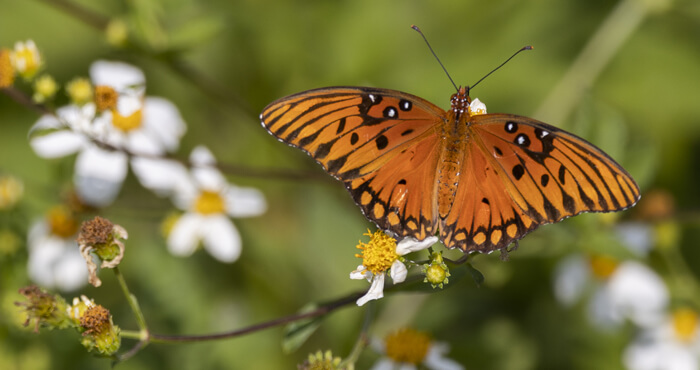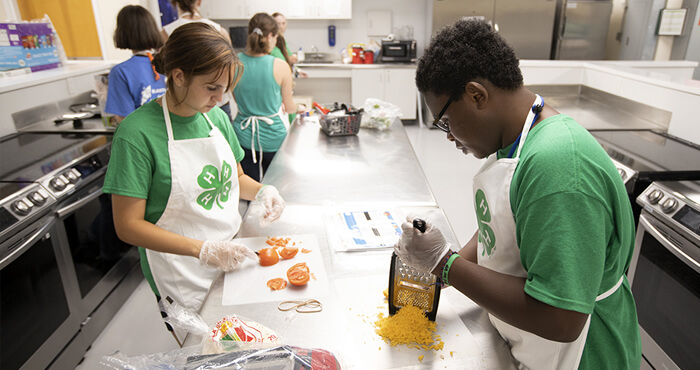
Africanized Honey Bees
Learn how to identify these insects and protect yourself and your family.
Introduction
Africanized honey bees (AHB) occur in Florida. AHBs breed and compete with the European-derived strains of honey bees (EHB) that are managed by beekeepers. Because AHBs are established in Florida, it is important to become familiar with AHBs and their behavior.
Although they are often referred to as killer bees, the correct term is Africanized honey bees. Another common mistake is describing them as aggressive. Their behavior is actually defensive - they react to human invasion of their environment and defend themselves/their nest when necessary. Attacks occur when people get too close to a nesting colony of AHBs.
Most people probably first hear about AHBs via B-grade movies such as "Killer Bees" (1974) and "The Swarm" (1978). Labeling AHBs as aggressive killers can provoke unjustified fear and hysteria. Fortunately, you do not have to learn about AHBs from bad horror movies or rumors on the Internet. These tips from the Florida IPM Office can help you educate and protect yourself and your family.
Avoiding AHBs & Protecting Yourself
Common AHB Nesting Sites
Be aware of the places where AHBs are likely to nest. Potential sites include:
|
|
Bee-Proof Your Property
The best defense is a good offense. Removing or blocking potential nesting sites around your yard and house reduces your risk of encountering AHBs at home.
- In order to 'bee-proof' a building, remove all potential nesting sites.
- From March to July (swarming season), inspect your property weekly for unusual bee activity.
- Seal all gaps larger than 1/8-inch in walls and around chimneys and plumbing.
- Install screens made of 1/8-inch hardware cloth over other openings, such as rain spouts, vents, cavities of trees and fence posts, water meters, utility boxes, etc.
If you do find bees nesting on your property, contact your county Extension agent, or a certified pest control operator or live bee removalist. A large percentage of feral honey bee colonies in southern Florida are AHBs. The Florida Department of Agriculture and Consumer Services (FDACS) currently recommends that all feral honey bee colonies be exterminated by certified pest control operators, or removed alive by a registered beekeeper who will requeen the colony with a EHB queen, allowing the colony to be placed back into agricultural production.
(Note: Exclusion of entry points is a principle of Integrated Pest Management (IPM) and will also keep out other unwanted pests.)
Encountering Defensive Bees
Do not stay in one place and swat the bees as this will cause the bees to sting. Remember, AHBs are trying to defend their nest. When a stinging event occurs, you are too close to the nest, and you need to leave the area immediately. Cover your nose and mouth with your shirt as you run. This restricts bees’ access to your airways.
When seeking shelter, do not hide in thick underbrush or water as it may take the bees thirty minutes or longer to leave an area. Look for enclosed locations, such as a building or vehicle. Some bees will probably enter the shelter with you, but most will remain outside.
If you see bees attacking someone, do not go to the victim and try to help. It is better to stand at a safe distance and yell to the person to leave the area as quickly as possible. If a defensive colony is encountered, contact emergency personnel or beekeepers who are trained to deal with AHBs.
What to Do if You are Stung
Stingers should be scraped out with a blunt object, such as a fingernail or credit card. Doing this as soon as possible will stop the release of venom. Wash the sting site with soap and water and apply ice to stop the swelling. Some swelling is normal and does not necessarily mean the victim is having an allergic reaction.
Some signs of an allergic reaction include:
- Hives
- Difficulty breathing
- Dizziness
If an allergic reaction occurs, or if you are concerned about your body's response to a sting, immediately contact emergency personnel. Use an emergency sting kit if one is available.
Don't Worry, 'Bee' Happy
Africanized honey bees can be frightening. You should respect them, but remember that their "killer bee" image comes from rumors and sci-fi movies, not from facts. Although AHB populations are generally more defensive than are EHB ones, EHBs also display defensive behavior, though at a much reduced level. The EHBs that beekeepers manage have been bred for docility.
In South America, where AHB populations are prevalent, pollination and honey production experienced a slight dip during the transition period between EHB/AHB hybridization. However, countries in South and Central America are now exporting honey again, and AHBs are being selectively bred to produce more docile bees.
AHB Resources
- UF/IFAS African Honey Bee Extension and Education
Find more information about AHBs, their removal, news and updates, as well as a list of resources - Choosing the Right Pest Control Operator for Honey Bee Removal: A Consumer Guide
UF/IFAS Extension publication that offers recommendations to any Floridian in need of contracting bee removal specialist - Bee Proofing for Florida Citizens
UF/IFAS Extension publication that instructs homeowners and property owners in the specifics of bee proofing and its importance - Frequently Asked Questions about the African Honey Bee in Florida
UF/IFAS Extension document that addresses frequently asked questions about the African bee in Florida - What to do About African Honey Bees: A Consumer Guide
UF/IFAS Extension EDIS document that offers recommendations and precautions to Florida's general public about the African honey bee - African Honey Bee
Florida Department of Agriculture and Consumer Services', Division of Plant Industry, Bureau of Plant and Apiary Inspection, African Honey Bee website
Adapted and excerpted from:
J. Ellis and F. Oi, "Africanized Honey Bees" (pdf), Entomology and Nematology Department (07/2006).
M. O'Malley, J. Ellis, A. Neal, What to Do About African Honey Bees: A Consumer Guide (ENY-141), Entomology and Nematology Department (12/2007).
NATURAL RESOURCES
- Africanized Honey Bees
- Biting & Stinging Insects
- Ecosystems & Species
- Invasive Species
- Water Resources
- Nuisance Wildlife
- Plants
- Sustainable Living - Environment
- Wildlife
RESOURCES
Related Sites & Articles
Hot Topics
UF/IFAS Publications
- African Honey Bee Information for School Administrators
- African Honey Bee: What You Need to Know
- FAQs about AHBs in Florida
UF/IFAS Sites
- IPM Florida
- School IPM
- UF Bee College
- UF Master Beekeeper Program
Other Sites & Publications



.jpg)

.jpg)